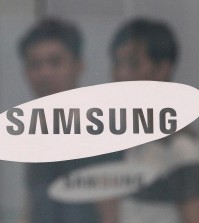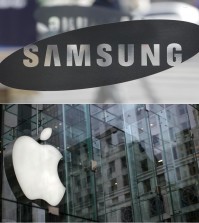- California Assembly OKs highest minimum wage in nation
- S. Korea unveils first graphic cigarette warnings
- US joins with South Korea, Japan in bid to deter North Korea
- LPGA golfer Chun In-gee finally back in action
- S. Korea won’t be top seed in final World Cup qualification round
- US men’s soccer misses 2nd straight Olympics
- US back on track in qualifying with 4-0 win over Guatemala
- High-intensity workout injuries spawn cottage industry
- CDC expands range of Zika mosquitoes into parts of Northeast
- Who knew? ‘The Walking Dead’ is helping families connect
Holography: Samsung’s next innovation engine

Holograms of singer Psy and dancers are screened at the Klive concert hall in Euljiro, Seoul, Jan. 16, which is capable of projecting holographic content. The venue and the concert have been co-arranged by the Ministry of Science, ICT and Future Planning, KT and YG Entertainment. (Courtesy of KT)
By Yoon Sung-won
What will be the next-generation technology that can bring genuine “innovation” to the global ICT industry?
The answer may vary.
Samsung Electronics, the world’s top smartphone maker, is considering holography technology as one of the new smart technologies after smartphones and wearable device technologies.
The current 3D display technology requires people to wear special eyeglasses to watch a stereoscopic image from the two-dimensional original image which is projected from a flat screen. The holography technology goes beyond this algorithm to produce images stereoscopically in the first place, freeing from a need for eyeglasses.
The holography technology can be applied to a wide range of industrial fields other than smart devices ― for example, medical science, construction and architecture, design, entertainment and performance, business conferences, art and televised media.
The smartphone market has been saturated and the profitability of wearable devices is said to be relatively limited because most of their functions work in sync with other smart devices like handsets and tablet computers.
For that reason, Samsung is likely to have eagerness to accumulate original technologies as well as patent rights related to the holography technology, in an effort to be an innovator, a “first-mover” in the future global market.
To realize the holography technology on smart devices, manufacturers first need to develop display panels with hardware capacity that is capable of describing a very high level of resolutions as well as application processors with faster computing speed.
During the U.S. Consumer Electronics Show 2014 held in January, one of the world’s biggest technology fairs, one of the most popular technologies introduced there was that 3D display that does not require special eyeglasses to watch stereoscopic images.
Together with much improved high-definition technologies, electronics companies including Samsung Electronics, Sharp and many other Chinese firms came up with next-generation 3D screens, raising expectations for the next-generation display technologies.
The next step in 3D technology is holograms, which are still in an infant stage of development. The key is to develop an algorithm to realize the stereoscopic images projected from a flat screen.
According to data from the U.S. -based patent-related researcher Innography about companies’ revenue and holography-related patents registered in the United States, Samsung, which already has strength in display technology, is likely to be a strong prospective consumer for these patents in the future with its profound revenue basis.
Since the holography technology is not yet established in the industry, each company has concentrated different methods of embodiment.
Japan’s Sony, one of the leaders in terms of holography technology, has developed or collected patents related to the head-mounted-type hologram display. Samsung Electronics has concentrated in improving optical elements and the hologram projection method to actualize the holography algorithm. Germany-based SeeReal Technologies has focused on eye-tracking technology, according to the data.
No matter how promising or important the holography technology may be, Samsung remains cautious about its future and about the company’s commitment into it.
“It is still too early to make an official statement about Samsung’s interest and development in the holography technology, though it can be one of many options,” a Samsung Electronics insider told The Korea Times. “Holography not only has a long way to go in its development process, but it also is too wide and complicated to refer to a technology applicable to a certain field.”












![일본 사도광산 [서경덕 교수 제공. 재판매 및 DB 금지]](http://www.koreatimesus.com/wp-content/uploads/2024/07/PYH2024072610800050400_P4-copy-120x134.jpg)


